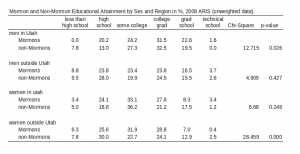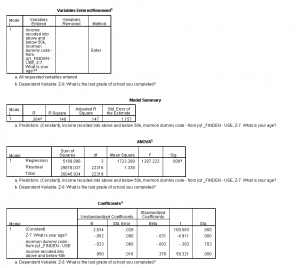Q: According to the Pew center, 32 percent of U.S. Mormons have “some college education.” This is the highest percentage I know of for any denomination (including non-Christian ones). However, only 18 percent have graduated from the college level (and 11 percent from a graduate education). Both of *these* figures, while still above the national percentage, Latter-day Saints are notably outperformed by Hindus and Buddhist (which may reflect the demographics of their emmigration), Jews, Orthodox Catholics, and the mainline denominations. Latter-day Saints tie with Roman Catholics and only outperform Evangelicals, historic Black churches, and Jehovah’s Witnesses. How is the LDS lack of completing their higher education best explained?
A: Several members of the MSSA responded with information to answer this question. However, it is worth noting that, while the question asked about college non-completion rates for Mormons generally, all of the experts below noted that this is likely tied to gender differences in college attendance.
Rick Phillips made an important point about the nature of the Pew data:
This is another example of how findings from Pew’s study are skewed because they oversampled counties in Utah. The trend of women dropping out of college and the low percentage of Utah college students that are female does not square with the ARIS’s more representative sample, which shows no significant difference in the number of LDS men vs. women who have a college degree. Note as well that ARIS shows that significantly more LDS women in Utah than LDS women elsewhere are stay at home moms, so Pew is documenting a Utah Mormon phenomenon that is not as pronounced in the total U.S. LDS population.
Sherry Baker noted that Susan R. Madsen and colleagues, from Utah Valley University, have done extensive research on why young women in Utah are not attending and completing college at the same rates as young women outside Utah. In one of the reports that was published based on that research, Dr. Madsen and her co-authors note that there is a connection to Mormon men serving missions. This is reflected in the odd disparities in college attendance rates in Utah by age and sex. At younger ages, women are closer to national averages in college enrollment, but that changes at older ages. Dr. Madsen and colleagues suggest that what is driving this is Mormon men returning from missions, who then enroll in college. The influx of returning Mormon missionaries would dilute the number of young women in college. However, their study also finds that young women in Utah are dropping out after their first one or two years. While it is not explicitly stated in Dr. Madsen’s research, the implicit suggestion is that women drop out after they find a husband to marry, probably a returned missionary. She also notes that women in Utah major in low-paying, low-skill areas, like education, and are substantially under-represented in higher-paying majors like business and STEM disciplines. Despite the above findings, in one of the reports, Dr. Madsen and colleagues conclude that devout female members of the LDS Church are encouraged to get a college education and seem to suggest that being LDS encourages college participation, rather than discouraging it. This may be a case where explicit directives on the topic of education from the leadership of the LDS Church suggest one thing – college education is important for women – but many implicit directives in other areas end up pushing women away from completing college. This is well-illustrated by another of Dr. Madsen and colleagues findings that Utah women have traditionally been better educated than the national average, but that historical pattern began to shift in 1993 and by 2000 Utah women were below average. The Proclamation on the Family was released in 1995, and it says,
“By divine design, fathers are to preside over their families in love and righteousness and are responsible to provide the necessities of life and protection for their families. Mothers are primarily responsible for the nurture of their children. In these sacred responsibilities, fathers and mothers are obligated to help one another as equal partners. Disability, death, or other circumstances may necessitate individual adaptation. Extended families should lend support when needed.” (full text here)
In other words, Mormon women are told to get college educations but are also told that their place is in the home, taking care of kids. The high rate of college non-completion is likely a result of the mixed messages these women receive.
Armand Mauss suggested that it would be difficult to arrive at a a definitive answer on this question without controlling for other variables:
I don’t think we can make much of such general figures without controls at least for age and for convert vs. lifer. Over the years, my impression from various data sets has been that the LDS Church tends to convert people of mainly modest education, who then produce children of much higher educational attainment.
In the interest of pursuing Dr. Mauss’s suggestion, I (Ryan Cragun), re-examined ARIS 2008 data to see what it can tell us about the educational attainment of Mormon men and women. To begin with, Mormon men in Utah do have significantly more education than do non-Mormon men in Utah. However, outside Utah, Mormon men do not have significantly more education than do non-Mormon men. For Mormon women there is a slightly different pattern. Inside Utah, Mormon women do not have significantly different educational attainment than do non-Mormon women; outside Utah Mormon women have significantly less education than do non-Mormon women. These findings are detailed in the table below:

As far as Mormon men vs. Mormon women goes, Mormon men do have significantly more education on average, but most of that education is at the upper end. There are negligible differences in college graduation rates across all Mormon men (26.2%) and women (28.4%), but Mormon men are substantially more likely to have graduate degrees (18.4%) than are Mormon women (7.4%). Also, Mormon women are more likely to have some college (32.3%) than are Mormon men (23.7), suggesting there is a phenomenon of Mormon women dropping out of college, probably once they find a husband. This data is shown in the table below:

However, there is a difference in educational attainment between Mormon men and women depending on where they live. Mormon women outside Utah are more likely to have completed college than are Mormon men, but less likely inside Utah. In both places, however, women are more likely to have some college than are men, as shown in the table below:

Finally, in an effort to more directly address Dr. Mauss’s point about controlling for age (convert status is not included in ARIS 2008), I ran two regressions. The dependent variable was educational attainment with the categories shown in the above tables (technically an ordinal variable, but used here as an interval-like variable). Educational attainment was regressed on (1) age, (2) whether or not the respondent is a Mormon (0=not Mormon; 1=Mormon), and (3) income (dummy coded as below $50,000 per year=0; above $50,000 per year=1).
The first regression included just the male participants in ARIS 2008. All three variables in the equation are significant. As age increases, educational attainment increases for Mormon men. Being Mormon increases educational attainment for Mormon men. And having more than $50,000 per year increases educational attainment (causality on this last one is, of course, tricky). Here are the results:

The second regression included just the female participants in ARIS 2008. Income is positively correlated with educational attainment. Age and being Mormon, however, are inversely correlated with educational attainment, though the dummy code for being Mormon is not significant. Here are the results:

In other words, even when you control for age and income, only men see educational benefits from “being Mormon”; Mormon women do not.

